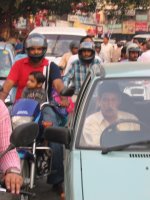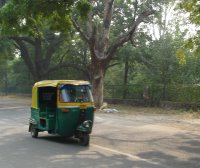There’s a whole range of modes of transportation here including walking, public transportation (bus and metro), cars, bicycles, motorcycles, auto rickshaw and taxi. People carry impressively large loads on their head, in carts, and on bicycles. The most impressive I’ve seen is a system of carrying a huge load on the back with a strap that ties the load to your head so the strap goes across the forehead.
In general, getting around is a rather frenzied, chaotic but surprisingly safe process. However, there’s a whole different set of safety standards one adopts once you set foot in this land. Seatbelts are virtually unheard of. Even if cars have them, they are clearly never used (stuffed in the seat or broken) even though it’s the law in Delhi. Everybody runs lights. It’s like lights are a guide for who can go next when there’s heavy traffic. Otherwise, people just drive on through—I don’t get exactly how it works. There are few accidents and collisions despite driving very closely together because traffic moves slower, on average, and people are used to it. Drivers beep their horns constantly to let other drivers know they’re there. When traveling, you often encounter beggars who weave in and out of stopped traffic in the middle of the street, selling goods such as magazines and rags, or just asking for money. Constantly—drivers always have one hand positioned over the horn. It’s used as a courtesy. Trucks and cars on the road have signs painted on the back of the vehicle, “Horn please.” Lanes are also a very rough road guide that are seldom observed. It’s common practice to drive down the road in two lanes at once.
Most of the Hindi I’ve learned is for the purpose of communicating and bargaining with auto rickshaw drivers. These are small men who work under terrible conditions (exposed to smog all day, and most of the smoke to boot) and most speak little English other than the price of a ride. Many of them are pretty slimey and will try to get away with as much as possible, especially from a Western woman. For example, when bargaining, a driver may take a lower price and say if the passenger agrees to make one or two stops. This is some sort of scam in which drivers drop tourists off at shops for 5-10 minutes before dropping them at their destination. Then, there’s the “no change” scam in which drivers claim they don’t have change even though they do.  Finally, there’s the total sleeze ball scam. The other day, we went to a market that was closed. Noticing western girls with no place to go, this guy approached us to ask what we were looking for and accompanied us to another market. He successfully found a store with what we were looking for and then took us to the India Government tourist office to get some travel info. As the driver was bringing us back, our guide asked, “Can I ask you something and you will promise not to get angry?”.Yeah, okay, what? “Do you want to sleep with me tonight?” Disgust.
Finally, there’s the total sleeze ball scam. The other day, we went to a market that was closed. Noticing western girls with no place to go, this guy approached us to ask what we were looking for and accompanied us to another market. He successfully found a store with what we were looking for and then took us to the India Government tourist office to get some travel info. As the driver was bringing us back, our guide asked, “Can I ask you something and you will promise not to get angry?”.Yeah, okay, what? “Do you want to sleep with me tonight?” Disgust.
To avoid all of this insanity, I enjoy walking—the most relaxing mode of transportation here—until you encounter a road, of course. There are few crosswalks. To cross six lane roads is kind of an art of locating the slow cars driving down the road, stepping in front of them, and making eye contact with the driver. I often opt to find a crossing buddy—another crosser whom I can just follow across—and think about how I should’ve brought my snow boarding helmet to India instead of a winter jacket.
No comments:
Post a Comment